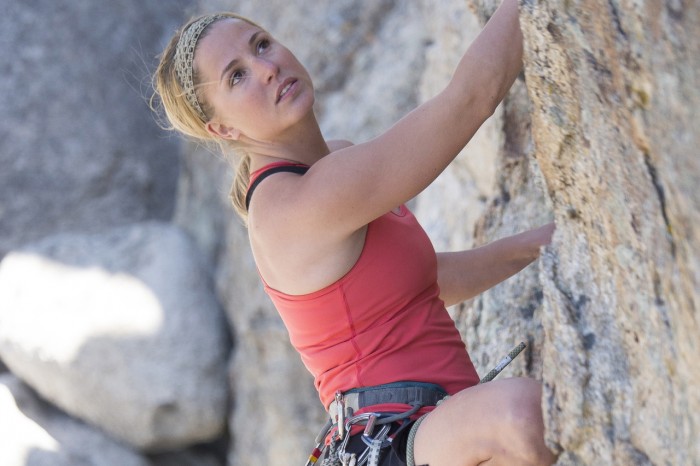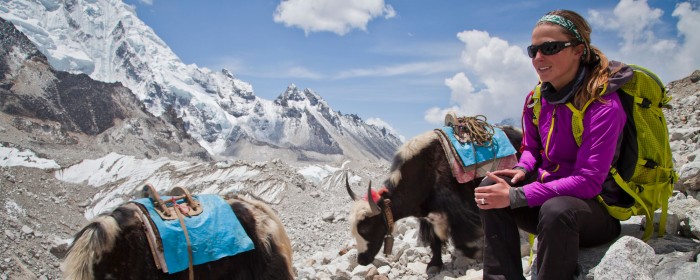Ladies We Love: Melissa Arnot

Melissa Arnot is more than a mountaineer. She’s fast becoming known as one of the world’s best female climbers and mountain guides. Last May, at the age of 29, Arnot climbed Everest for the fifth time, setting the world record for the second most Everest summits held by any woman (Lakpa Sherpa has accomplished six Everest climbs).
Arnot’s high-mountain adventures began 10 years ago with a passion to climb mountains and travel the world. She lived in her Toyota pickup while working as a guide apprentice for Rainier Mountaineering. Now, she’s summited Mt. Rainier more than 100 times. Over the past six years she’s traveled to Nepal 13 times for both guiding and personal expeditions—she’s away from her Ketchum, Idaho, home an average of eight months out of the year. And, in 2012, she co-founded The Juniper Fund, a non-profit that provides assistance to local mountain workers (and their families and communities) who have been adversely impacted by their work for the mountain-based adventure industry.
In April 2013, she witnessed a violent fight break out on Everest between a group of Nepali Sherpa guides and professional alpinists. Three years earlier, her friend and climbing partner Chhewang Nima Sherpa was killed in an ice avalanche. Here, we caught up with Arnot on these issues and more before she went back to Everest basecamp, where she is now deeply involved in the rescue and recovery efforts resulting from the recent deadly avalanche that claimed the lives of 13 Sherpa guides. Please consider making a donation to Melissa Arnot’s The Juniper Fund, which will provide assistance to the families of those Sherpas killed on Everest.
WM: You’ve climbed Everest five times since 2008—how has that experience changed over time?
Melissa Arnot: The climbing industry there is really young—20 years is really young. For the past six seasons I’ve been able to see the guiding community and society change, and see the changes in operation. When I first went in 2008 there were only one or two women. Lydia Bradey was guiding her second trip and Amy Bullard had guided a trip in 2004, but those were the most times that any female guide had worked there. And, the local Sherpa people are very blunt. They’d say, ‘No woman is a mountain guide. Woman takes care of house, takes care of family.’ Then, I remember in 2010 someone introducing me as a ‘guide.’ I work really hard, and after six seasons the Sherpa people really respect that I’m a guide, and I’m really respected as a working member of that community.
WM: How has the experience changed mentally?
Melissa Arnot: When you do something one time you have that [one] experience. Now, I have something to compare it to. It’s the base. It’s the currency experience. And, I may be getting wiser in my old age. That’s the balance beam that I walk on Everest—between greed and wanting to learn more, and being thankful for learning so much. I’m very reactive in my life and I take each experience and grow a new one. I also have a responsibility to not be a spectator for what’s happening on Everest and how things are changing, and my motivation has changed.
WM: What’s your perspective on the scuffle that happened on Mt. Everest?
Melissa Arnot: It was a really sad experience and something that was really unpredictable for me, and I’m focused on moving away from it. Even though I was involved, it doesn’t make me any more qualified to speak on the causes. My focus is for making a sustainable working environment for all the people that want to climb on Everest.
WM: In the past 10 years, have you noticed any changes regarding how society or the climbing culture views women in the sport?
Melissa Arnot: I’m fairly unassuming. I’m not bulky. I’m feminine. If people had to guess my profession, they normally couldn’t. I hope that’s helping how we view the women who do it, and is helping those views to change. It’s also hard to watch yourself in the middle of a social change because you’re so involved in it: I hope it’s happening.
WM: What are your mountaineering goals? Are there any specific peaks you want to climb or records you want to set?
Melissa Arnot: Record setting is something that’s naturally happening, but I’m not pursuing it. Makalu—30 miles from Everest—is my long-standing dream mountain. I attempted it in 2011 but didn’t summit. But, I’ve learned a lot in the last few years since I was there, so maybe next spring.
WM: Why didn’t you summit?
Melissa Arnot: A variety of reasons. The weather was difficult, we weren’t as climatized as we needed, and climbing without Sherpas. We weren’t climbing at a rate that was acceptable on summit day. You’re almost 1,000 [feet] higher on Everest, but [Makalu] is much more technical than Everest.
WM: Where do you see yourself in five years?
Melissa Arnot: I have no idea, I’m extremely reactive; for me, it’s positive. I take each opportunity I have and turn in that direction. I have no overarching plans. I’ll just have to see how it goes from this year to next year.
Kamagra oral jelly Online something to buy the most convenient way. He doesn’t demand from you any actions except how to visit the website. And in separate with goods necessary to you to put the end. To specify your address and to wait for the supplier to whom you will give money.



LET'S GET SOCIAL